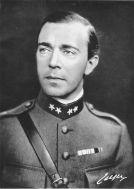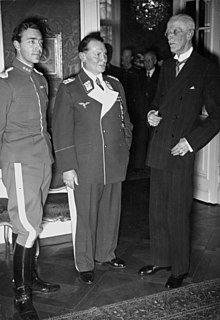Prince Gustaf Adolf, Duke of Västerbotten
 Prince of Sweden Duke of Westrobothnia |
Gustaf Adolf, Gustaf Adolf Oscar Fredrik Arthur Edmund (April 22, 1906–January 26, 1947), Prince of Sweden, Duke of Västerbotten, was the eldest son of Gustaf VI Adolf of Sweden and his first wife Princess Margaret of Connaught. His mother was a granddaughter of Queen Victoria since she was the daughter of HRH Prince Arthur, Duke of Connaught and his wife, Princess Luise Margarete of Prussia.
On October 19, 1932 he married his second cousin, Princess Sibylla of Saxe-Coburg-Gotha, daughter of Carl Eduard, Duke of Saxe-Coburg and Gotha. Princess Sibylla was a great-granddaughter of Queen Victoria, a granddaughter of HRH Prince Leopold, Duke of Albany. They had five children:
- Princess Margaretha, Mrs. Ambler (1934-)
- HRH Princess Birgitta (1937-)
- Princess Désirée, Baroness Silfverschiöld (1938-)
- Princess Christina, Mrs. Magnusson (1943-)
- HM King Carl XVI Gustaf (1946-)
According to some recent journalists and historians Gustaf Adolf is supposed to have been sympathetic towards the Nazi movement in Germany in the 1930s, an opinion which has been highly debated and criticized. It is a fact that Gustaf Adolf as an official representative of Sweden met with many of the Nazi leaders, including Adolf Hitler and Hermann Göring (the latter had lived in Sweden and had many friends among the Swedish upper class), but since the prince very rarely spoke of political matters and left no written evidence of any political sympathies of any kind the subject is very much a matter of speculation. These rumours however made him unpopular among many Swedes during his life time. The public called him tyskprinsen (the German prince). However, according to the journalist and author Staffan Skott in his book Alla dessa Bernadottar (All these Bernadottes; Albert Bonniers press), these rumors are disproven by letters and diary entries by influential Swedes of decidedly anti-nazi persuasion, including the diplomat Sven Grafström and the wife of a government minister Gustav Möller, as well as the stepson of Hermann Göring who said that a visit by the crown-prince to Göring's home was a complete failure and that Göring and Gustaf Adolf did not get along well. Also the anti-nazi newspaper Expressen said that the rumors had been denied by "plausible witnesses who were also strongly pro-democracy". The Swedish Royal Court also has made a statement denying any knowledge of Nazi-sympathies. [1]
Death

Prince Gustaf Adolf was killed in a plane crash on the afternoon of January 26, 1947 at Kastrup, Denmark. The prince, along with two companions, was returning to Stockholm from a hunting trip and visit to Crown Princess Juliana and Prince Bernhard of the Netherlands. The delayed KLM flight from Amsterdam had landed at Copenhagen for a routine stop before continuing to Stockholm. Soon after the Douglas DC-3 aircraft took off, it climbed to an altitude of about 50 meters (150 feet), stalled, and plummeted nose-first to the ground where it exploded on impact. All 22 people aboard the plane (16 passengers and six crew members) were killed. Also aboard the ill-fated flight was American singer and actress Grace Moore. The investigation showed that the crash had been caused by a forgotten rudder lock. Short of time, the captain never performed his checklist and took off not realizing the gust lock was still in place.
At the time of his death, Prince Gustaf Adolf had been second in line to the Swedish throne behind his father, who in 1950 became King Gustaf VI Adolf.
| Styles of Prince Gustaf Adolf of Sweden | |
|---|---|
| File:Sweden greater arms.png | |
| Reference style | His Royal Highness |
| Spoken style | Your Royal Highness |
| Alternative style | Sir |
